


There are over 20,000 various spider species in America. In Texas, there are nearly 900 species of spiders. Most all spiders
deliver a venomous bite which is necessary to their feeding habits, however not all of them can bite a human. Of those that are able
to bite a human, the amount of venom delivered is usually small and lacks the potency to cause any real medical concern,
regardless, the bite may still be very painful similar to that of a bee sting. It should be noted, that there is always the risk for a few
individuals to suffer a serious allergic reaction to any spider bites. Only two species of spiders in Texas are known to be seriously
poisonous to all humans and may deliver a bite with enough venom and potency to cause medical concern: The Brown Recluse
and The Black Widow.
Although, most spiders are harmless, they can become a real nuisance when they are in and around our homes. When
encountered, they can be quite frightening to children and adults alike.
Southwestern A-1 Pest Control can help you to keep these critters at bay. Call us or use our web form to make an appointment
today.
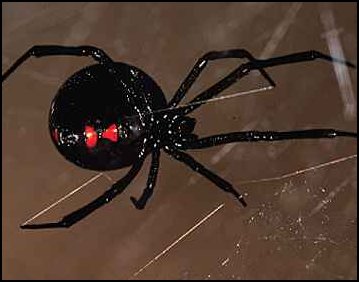
Black Widow
The venomous Black Widow is fairly easy to recognize. They have a
large smooth black to dark brown abdomen. The female Black Widow is
normally shiny black, with a red hourglass marking on the underside of
the abdomen, however the marking may range in color from yellowish
orange to red and its shape may range from an hourglass to only a dot.
Some females may have no markings at all.
The males are dark brown with red spots and white flecks on their
backs.
Symptoms usually results in headache, nausea, vomiting, abdominal pain, pyrexia and hypertension. The pain around the bite
area has been reported to be excruciating at times and unnoticed at others.
First aid and medical attention should be sought as soon as possible, if bitten. If you have heart condition or other heart problem,
you may need hospitalization.
They are most often found in woodpiles, rubble piles, under stones, in hollow stumps, sheds and garages. Indoors it can be found
in undisturbed, cluttered areas in basements and crawl spaces.
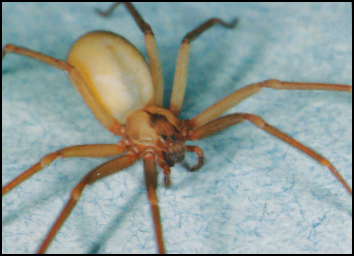
Brown Recluse
The brown recluse is a venomous spider wtih distinct markings on the back
of their body in the shape and pattern of a violin. This violin pattern has the
large part of the violin towards the spider head and violin neck pointing
toward the rear. They tend to hide out in warm, dry, dark cluttered areas
such as closets, attics, barns, porches, old tires, woodpiles and
basements.
They do not build webs and are most active when they are hunting for prey.
Although they are poisonous, the brown recluse spiders are not known to
be aggressive and only bite when they are threatened or when a humans
foot, hand or arm accidentally comes into contact with them.
Most brown recluse bites happen in summer months. They often go
ununnoticed in the beginning due to the fact that bites are usually painless.
In some cases there may be a certain amount of burning sensation such as
that from a bee sting.
Six to eight hours following the initial bite of a Brown Recluse, symptoms should be monitored closely. At first, the site of the bite may be a little red and when examined closely may indicate fang marks. The venom will begin to destroy surface and underlying skin tissue which will trigger an immune response in the body designed to "quarantine" the venom from other parts of the body.
The patient may begin to experience intense pain and itching at the bite site, as well as possible blistering, swelling or pustule formation. Meanwhile, the destruction of red blood cells will cut off the supply of oxygen to the skin creating a zone of gray, oxygen-deprived tissue.
If the venom escapes the quarantine and enters into the bloodstream, the venom will start to affect the entire body.
If after these skin-related symptoms you begin to experience fever, nausea, dizziness, chills or a rash of red-colored dots on your body in areas outside of the bite it means that the venom is circulating in your bloodstream. This could quickly lead to seizures, kidney failure, coma or even death.
The patient may begin to experience intense pain and itching at the bite site, as well as possible blistering, swelling or pustule formation. Meanwhile, the destruction of red blood cells will cut off the supply of oxygen to the skin creating a zone of gray, oxygen-deprived tissue.
If the venom escapes the quarantine and enters into the bloodstream, the venom will start to affect the entire body.
If after these skin-related symptoms you begin to experience fever, nausea, dizziness, chills or a rash of red-colored dots on your body in areas outside of the bite it means that the venom is circulating in your bloodstream. This could quickly lead to seizures, kidney failure, coma or even death.
Texas provides habitats to a number of look-a-like spiders that are often
and easily mistaken for the poisonous variety. The Wolf Spider and House
Spider are two that are often mistaken for the Brown Recluse
WOLF SPIDER
HOUSE SPIDER
Below are photos of other spiders that are common in our area.
GROUND SPIDER
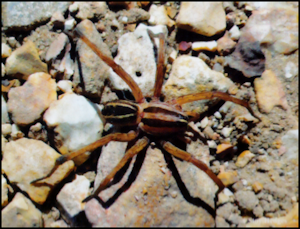
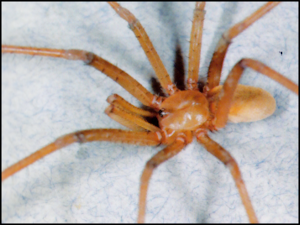
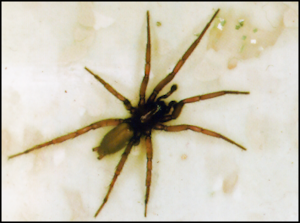

HOBO SPIDER

TARANTULA

SPIDERS
The black widow builds webs, which makes it easier for you to spot it.
They are not naturally aggressive but will bite when it feels threatened.
The Black Widow Spider can inflict a painful bite which can be fatal,
especially to the young and elderly. The Black Widows venom is potent
enough to cause serious illness, as the poison attacks the nervous
system.
LEARNING CENTER




